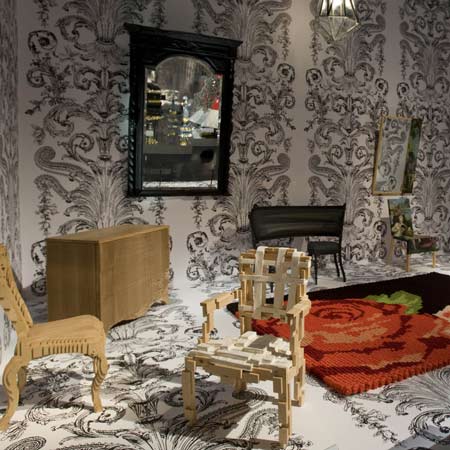An exhibition of limited-edition design including work by Atelier Van Lieshout, Boym Partners and Studio Makkink & Bey opened at the Victoria & Albert Museum in London yesterday.
The work on show is divided into three sections; the Forest Glade presents work inspired by fairytales, myths and nature, the Enchanted Castle displays objects usually associated with wealth and status that have been subverted, while Heaven and Hell explores themes of mortality.
Telling Tales: Fantasy and Fear in Contemporary Design is curated by Gareth Williams and runs until 18 October.
Photos: V&A Images unless stated otherwise.
Here's some more information from the V&A:
--
Telling Tales: Fantasy and Fear in Contemporary Design
14 July 2008 – 18 October 2009
This exhibition explores the recent trend among European designers for unique or limited edition pieces that push the boundaries between art and design.
It showcases furniture, lighting and ceramics, designed by a new generation of international designers, including Tord Boontje, Maarten Baas, Jurgen Bey and Studio Job, who are all inspired by the spirit of story-telling.
Each tells a tale through their use of decorative devices, historical allusions or choice of materials, sharing common themes such as fantasy, parody and a concern with mortality.
Above: The Fig Leaf wardrobe, 2008. Designed by Tord Boontje. © Meta
The exhibition is in three sections: The Forest Glade is inspired by fantasy and nature evoking the spirit of fairytales. The Enchanted Castle exaggerates and parodies historical design styles often associated with displays of status. Heaven and Hell is concerned with themes of mortality and the afterlife.
Above: Garden House by Jurgen Bey for magazine “Eigen Huis” assisted by Christiaan Oppewal & Silvijn v/d Velden / 2002. Photographer: Studio Makkink & Bey
The Forest Glade
Against all the evidence of an industrialised, globalised, high-tech world (or perhaps because of it) some contemporary designers are retreating to the pastoral setting of fairy tales, myths and nature. In so doing they return us to our most primitive state. No doubt their designs are escapist, even naïve, and can be quite deliberately childlike.
Above: Flower Pyramid, 2008, Studio Job, © the artists. Courtesy of Royal Tichelaar Makkum Photo: Studio Marten Aukes. More info
Their faux-rustic objects look as though they belong in a forest glade straight from classical mythology or northern European fairy tales, or perhaps even the biblical Garden of Eden. But these designers are deadly serious about wanting to disengage us from ordinary life and reconnect us to a state of innocence and wonder.
Above: Robber Baron table, 2006, Studio Job. © Studio Job Photo: R. Kot, Brussels. More info
The Enchanted Castle
We now enter an Enchanted Castle furnished with marvellous and fantastical objects. Many recall designs from the 18th century, a period that was frequently evoked by later writers and illustrators of fairytales. The 18th century was also the age of the rise of the novel, a new way to tell tales. Early novels, such as Daniel Defoe's Moll Flanders (1722), were descriptions of the material world of Georgian life, as were William Hogarth's print series, such as Marriage à la Mode (1745).
Above: Pixelated Chair, 2007 by Studio Makkink & Bey. Photo: Alain Speltdoorn, courtesy of Studio Makkink & Bey. More info
In both, style and design were a visual language that indicated social and worldly status. Here we see conventional displays of high status parodied and subverted, through awkward changes of scale or seemingly inappropriate uses of materials.
Above: Robber Baron cabinet, 2006 by Studio Job © Studio Job. Photo: R. Kot, Brussels. More info
Heaven and Hell
At the end of the 19th century, the advent of psychoanalysis opened up the sub-conscious and offered new interpretations of dreams and the imagination. With this came a renewed awareness of mortality and a sense of anxiety about the mutability of life, which Freud described as the 'death drive'. Inspired by this, we here present works that evoke the universal conflict of life and death, heaven and hell, judgement and salvation.
Above: Ultimate Art Furniture chair, 2006 by Boym Partners. © Boym Partners. More info
Some of these designers refer to the forms of Baroque art, others conjure up memento mori - reminders of our mortality. Still others create agitated designs that explore our anxious state in troubled times.
Above: Napoléon à Trotinette chair, 2005 by Vincent Dubourg. © Vincent Dubourg. Courtesy of Carpenters Workshop Gallery. More info
Above: Lathe chairs VIII, 2008 by Sebastian Brajkovic. © Sebastian Brajkovic. Courtesy of Carpenters Workshop Gallery. More info
Above: Sensory Deprivation Skull, 2007 by Atelier Van Lieshout. Reinforced fibreglass. More info
Above: Perished Bench, 2006 by Studio Job. © Studio Job. More info
Above: White Carrara Marble Cinderella Table, 2008 by Demakersvan/Jeroen Verhoeven. © Demakersvan/Jeroen Verhoeven. Courtesy of Carpenters Workshop Gallery
Above: The Clone Chair, 2005 by Julian Mayor. © the artist
Above: The Fall of the Damned Chandelier by Luc Merx. model: Damned.MGX. © the artist, courtesy .MGX by Materialise. More info
Above: Flower Pyramid, 2008 by Studio Makkink & Bey for Pyramids of Makkum. Koninklijke Tichelaar Makkum, 2008. © Courtesy of Royal Tichelaar Makkum. Photo: Studio Marten Aukes. More info
Above: Sculpt wardrobe, 2007 by Maarten Baas. © Maarten Baas. Courtesy of Carpenters Workshop Gallery. Photograph Maarten van Houten. More info
Above: Smoke mirror, 2008 by Maarten Baas. © The Artist. More info
Above: Flower Pyramid, 2008 by Hella Jongerius for Pyramids of Makkum. Koninklijke Tichelaar Makkum, 2008 © Courtesy of Royal Tichelaar Makkum. Photo: Studio Marten Aukes. More info

